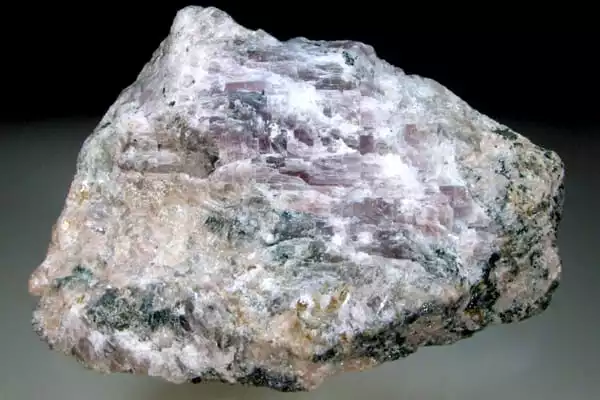Descriptions
Anhydrite is a rare mineral because it rapidly transforms into the much more common mineral gypsum when water is added to its chemical composition. Anhydrite and gypsum are chemically identical, with the exception that gypsum contains water. In reality, the term “anhydrite” is derived from the words “an” and “hydra”—meaning “without water”—in reference to its resemblance to gypsum but the absence of water. Some specimens only partially change to gypsum, leaving one part anhydrite and one part gypsum. Many deposits that originally had a high concentration of anhydrite now have a high concentration of gypsum, which was generated by the modification of the anhydrite.
In short, anhydrite is an anhydrous calcium sulfate having the formula CaSO4. It is linked to gypsum, which has the chemical formula CaSO4.2H2O. On a global scale, the quantity of gypsum much outnumbers that of anhydrite.
History
A. G. Werner named anhydrite in 1804 because of the absence of water during crystallization, as opposed to the presence of water in gypsum. Muriacite and karstenite are two outdated names for the species; the former, an older term, was given under the misconception that the material was a chloride. Tripe-stone is a rare variant found as distorted concretionary masses, while vulpinite is a scaly granular type found in Volpino, near Bergamo, in Lombardy; the latter is cut and polished for aesthetic uses.
Occurrence of Anhydrite
Calcium sulfate is deposited as gypsum crystals from an aqueous solution. However, when the solution contains an excess of sodium or potassium chloride, the anhydride is deposited as the temperature rises beyond 40 °C (104 °F). This is one of the techniques for artificially preparing the mineral, and it is the same as its natural origin. It is prevalent in mineral salt basins. In hydrothermal deposits, anhydride is also produced as a vein filling mineral. In sulfide mineral occurrences containing calcite and halite, the solution is often left as a gangue. Anhydrite is also found in the salt domes’ cap rock and trap rock chambers.

Physical Properties and Identification
Anhydrite’s cubic cleavage is one of its most distinguishing characteristics. It cleaves at right angles in three directions. This is plainly visible in coarsely crystalline specimens and may be observed with a hand lens in fine-grained specimens. Anhydrite is known as the “cube spar” because of its characteristic cleavage. When anhydrite is in huge form, it might be difficult to recognize. It is frequently mistaken with gypsum, calcite, or halite, with which it is virtually invariably linked. Anhydrite has a higher hardness and cleavage in three directions at right angles than gypsum. It may be recognized from calcite by its right-angle cleavage and lack of acid reaction. Anhydrite is insoluble and somewhat harder than halite.
| Chemical Formula | CaSO4 |
| Chemical Classification | Sulfate |
| Color | Colorless, white, and light shades of brown, red, gray, pink, blue, violet |
| Diaphaneity | Transparent to Sub transparent to translucent |
| Fracture | Brittle – Conchoidal – Very brittle fracture producing small, conchoidal fragments. |
| Hardness | 3 to 3.5 |
| Luster | Vitreous to pearly |
| Streak | White |
| Specific Gravity | 2.9 to 3 |
| Crystal System | Orthorhombic |
Uses of Anhydrite
In some applications, anhydrite can be used in place of gypsum. Both minerals are crushed for use as a soil treatment, with anhydrite being better. Because gypsum is around 21% water by weight, one ton of anhydrite has more calcium than one ton of gypsum. In a soil application, this results in more calcium per ton. Anhydrite is also more soluble, which allows it to benefit the soil more quickly. Anhydrite is used in small doses as a drying agent in plaster, paint, and varnish. It is also used with gypsum to make plaster, joint compound, wallboard, and other building materials. Anhydrite has also been utilized as a sulfur source in the manufacture of sulfuric acid.





